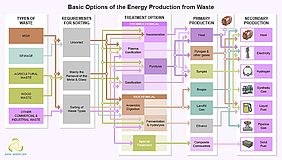In September this year, the World Bank published “Waste Global Database” on their website. In their earlier paper “What a Waste 2.0: A Global Snapshot of Solid Waste Management to 2050”, the authors reported that 3.40 billion tonnes of waste would be generated worldwide by 2050, against today’s 2.01 billion tonnes. This colossal renewable resource requires close attention since it is both a source of significant greenhouse gas emissions, a raw material for the production of heat and electricity, and a potential basis for creating new jobs. In the last decade, tangible progress has been achieved in waste processing. According to IRENA, in 2017 the total capacity of power plants using municipal waste as raw materials amounted to about 12 GW, while producing about 60 GWh of electricity. Various technologies are used for waste processing, most often direct incineration. The greatest successes were achieved by Switzerland, Sweden, Denmark and some other countries. Landfill gas technologies are popular in the United States and Brazil, and gasification technologies are developing successfully in Japan and Canada.
However, the potential of waste resources is far from being exhausted, as are the positive organizational experience and serious technical advances. More than 30% of the world's waste accumulates in open landfills, and in many large cities the slightest disruptions of public services lead to the collapse of normal life. Effective waste disposal requires coordinated legislative initiatives, significant financial investments, timely decisions and discipline of citizens, especially in terms of waste separation.
The proposed World Bank database contains and categorizes information covering almost all countries around the world and more than 330 cities. Numerous indicators are presented for waste management, including food organic waste percentage, plastic percentage, information governing national legislation, municipal waste generated, percentage of anaerobic digestion, percentage of landfill with controlled cleaning, percentage of incineration, annual budget for waste management, and more.
The database can be an excellent handbook for businesses dealing with the commercialization of municipal waste disposal, when optimizing executive decisions and as a statistical reference for other interested organizations. The access to the database is free, and its use is regulated by the CC-BY 4.0 license.
